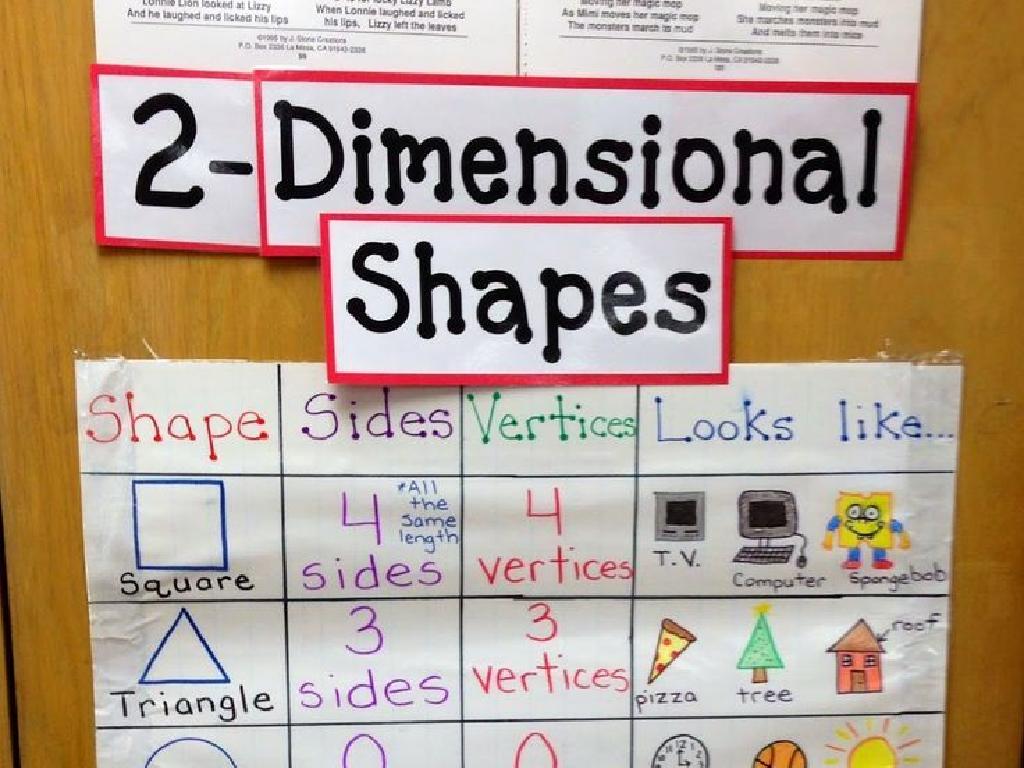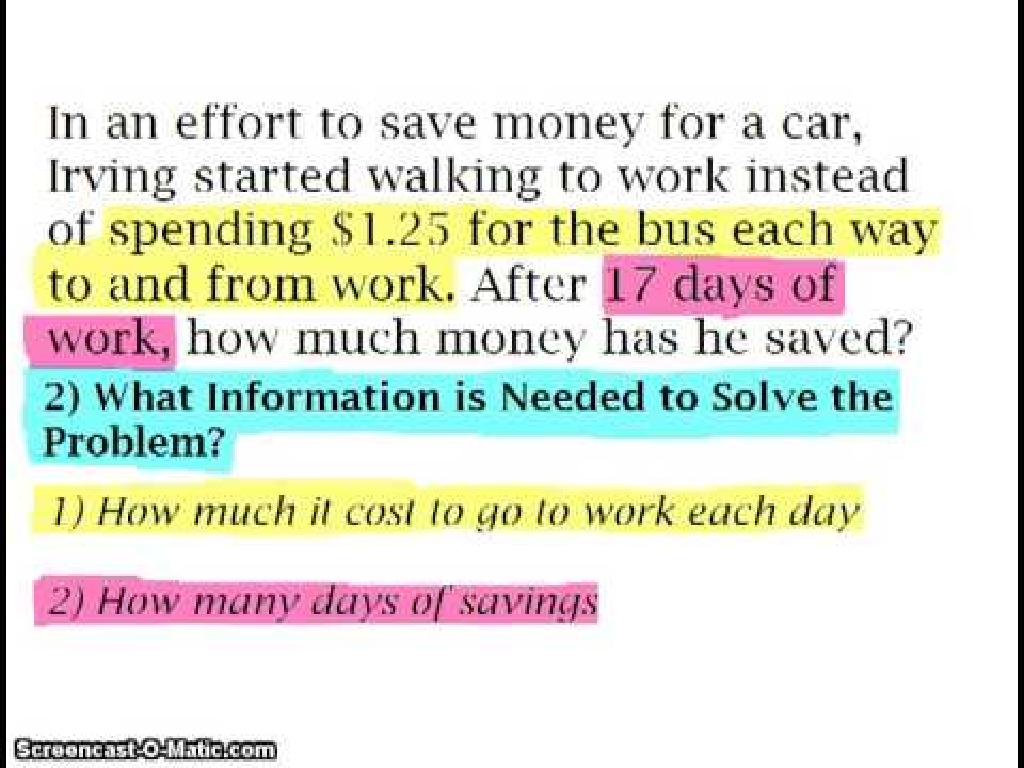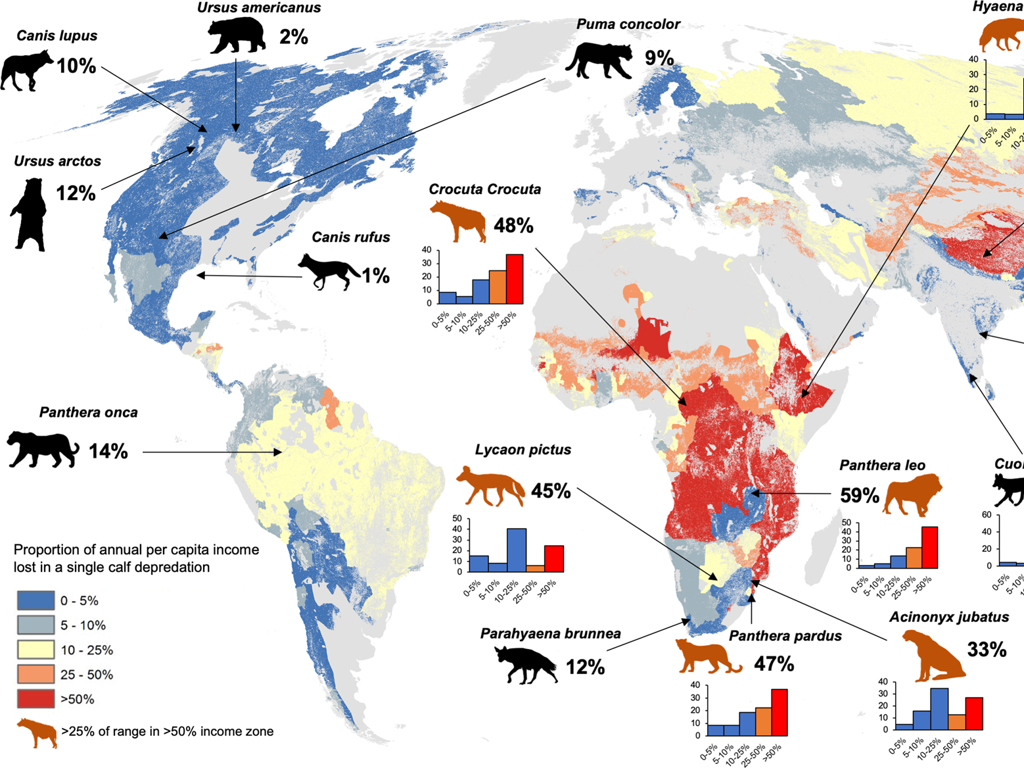Identify The Irregular Past Tense Ii
Subject: Language arts
Grade: Third grade
Topic: Verb Tense
Please LOG IN to download the presentation. Access is available to registered users only.
View More Content
Irregular Past Tense Verbs Part II
– What are irregular verbs?
– Verbs that don’t follow regular rules
– No ‘ed’ in irregular past tense
– Examples: ‘run’ becomes ‘ran’
– ‘Buy’ turns to ‘bought’, not ‘buyed’
– Practice makes perfect!
– We’ll practice with fun activities!
|
This slide introduces the concept of irregular past tense verbs to third graders. Begin by explaining that irregular verbs are special verbs that do not follow the usual rule of adding ‘ed’ to form the past tense. Provide clear examples of common irregular verbs and their past tense forms, such as ‘run’ to ‘ran’ and ‘buy’ to ‘bought’. Emphasize that memorization and practice are key to mastering these verbs. Plan engaging activities where students can practice converting present tense verbs to their irregular past tense forms in sentences, and encourage them to share examples they already know. The goal is to make them comfortable with using these verbs in both spoken and written English.
Understanding Verbs: Action Words
– Verbs show actions or states
– Verbs tell us about what’s happening
– Examples: run, jump, eat
– ‘Run’ for speed, ‘jump’ for leaping
– Think and play are also verbs
– ‘Eat’ for consuming food, ‘think’ for using your mind
– Verbs are important in sentences
– Without verbs, sentences have no action
|
This slide introduces the concept of verbs to third-grade students. Emphasize that verbs are not just physical actions like running or jumping, but also include states of being or mental actions like thinking and playing. Use examples that are relatable to the students’ daily activities. Encourage them to come up with their own examples of verbs. Explain that verbs are crucial for constructing sentences because they tell us what the subject is doing. In the next class, we will explore irregular past tense verbs, which do not follow the usual rule of adding ‘-ed’ to the base form.
Regular vs. Irregular Verbs
– Regular verbs add ‘-ed’ for past tense
– Irregular verbs change differently
– Examples: ‘walk’ becomes ‘walked’
– ‘look’ turns to ‘looked’, ‘play’ to ‘played’
– Examples: ‘go’ becomes ‘went’
– ‘eat’ turns to ‘ate’, ‘sing’ to ‘sang’
|
This slide introduces the concept of regular and irregular verbs to third graders. Regular verbs are straightforward; they follow a pattern where you add ‘-ed’ to make the past tense. For example, ‘talk’ becomes ‘talked’. Irregular verbs, however, don’t follow this rule and change in various ways, which can be challenging for students. ‘Go’ becomes ‘went’, and ‘eat’ becomes ‘ate’. It’s important to provide several examples and perhaps engage the class with a few interactive activities where they convert present tense verbs to past tense, identifying which are regular and which are irregular. This will help solidify their understanding of the concept.
Irregular Past Tense Verbs II
– Verbs that change in the past
– ‘Go’ becomes ‘went’
– Example: Yesterday, I went to the park.
– ‘Have’ changes to ‘had’
– Example: I had a great time last weekend.
– ‘Do’ turns into ‘did’
– Example: Did you do your homework?
|
This slide introduces students to irregular past tense verbs that do not follow a set pattern and change completely from present to past tense. Use examples to illustrate the changes: ‘go’ becomes ‘went’, ‘have’ changes to ‘had’, and ‘do’ turns into ‘did’. Encourage students to think of sentences using these verbs in the past tense. Provide additional examples and ask students to come up with their own sentences as well. This will help them understand and remember the irregular forms. Make sure to emphasize that these verbs do not follow the regular ‘-ed’ ending pattern and must be memorized.
Irregular Past Tense Verbs: More Examples
– ‘Cut’ stays the same in past tense
– ‘I cut the paper.’ Even in the past, ‘cut’ is still ‘cut’.
– ‘See’ changes to ‘saw’ in past tense
– ‘I see a bird.’ becomes ‘I saw a bird.’ in the past.
– Practice with sentences
– Understand through examples
– Examples help us remember how these verbs change.
|
This slide aims to provide additional examples of irregular past tense verbs to help students recognize patterns and understand that not all verbs follow the same rules when changing to past tense. Some verbs, like ‘cut’, do not change form, while others, like ‘see’, change to a completely different word, such as ‘saw’. Encourage students to create their own sentences using irregular past tense verbs and share them with the class. This practice will reinforce their understanding and help commit these irregular forms to memory. Provide guidance and correction as needed to ensure proper usage.
Practice Time: Irregular Past Tense Verbs!
– Listen to the present tense verb
– Shout out the past tense form
– Start with the verb ‘run’
– What is the past tense of ‘run’?
– ‘Run’ becomes ‘ran’ in the past tense
|
This slide is for an interactive classroom activity to help students practice irregular past tense verbs. The teacher will say a verb in the present tense, and students will respond by shouting out the past tense form. This activity is designed to be fun and engaging, helping students to learn through participation. The teacher should encourage students to speak up and praise them for correct answers, providing gentle corrections as needed. Additional verbs to use after ‘run’ could include ‘go’ (went), ‘come’ (came), ‘see’ (saw), and ‘take’ (took). This exercise helps reinforce the concept that irregular verbs do not follow a standard pattern and must be memorized.
Let’s Write: Irregular Past Tense Verbs
– Write the past tense of ‘fly’
What did ‘fly’ become in the past?
– Find the past tense of ‘take’
How did ‘take’ change when it happened before?
– Convert ‘sing’ to its past tense
What’s the past form of ‘sing’?
– Share your answers with a partner
|
This slide is an interactive class activity designed to help students practice converting present tense verbs to their irregular past tense forms. Encourage students to think about how each verb changes when talking about past events. For example, ‘fly’ becomes ‘flew’, ‘take’ becomes ‘took’, and ‘sing’ becomes ‘sang’. After writing down the past tense forms, students should pair up to compare their answers and discuss any differences. This peer interaction reinforces learning and helps students correct any misconceptions. As a teacher, circulate around the room to offer guidance and ensure that each student understands the concept of irregular past tense verbs.
Irregular Past Tense II Challenge
– Fill in the blank spaces
– Use the correct irregular past tense
– Example: ‘Yesterday, I _____ (build) a sandcastle.’
– Think about what word fits the action that happened yesterday.
– Answer: ‘built’
– ‘built’ is the irregular past tense of ‘build’.
|
This slide introduces a class activity focused on practicing irregular past tense verbs. Students will be given sentences with blanks where they need to fill in the correct irregular past tense form of the verb in parentheses. Start with the provided example to demonstrate how to approach the exercise. Encourage students to think about actions that have already happened and to recall the irregular forms they’ve learned. During the activity, circulate around the room to offer help and ensure understanding. After completing the exercise, review the answers as a class to reinforce learning. Prepare additional sentences for students who finish early or need extra practice.
Class Activity: Verb Tense Treasure Hunt
– Find action-inspiring objects
– Write present and past verbs
– For example, ‘draw’ in the present is ‘drew’ in the past
– Share your verbs with the class
– Learn irregular past tense forms
– Discover verbs like ‘go’ became ‘went’ and ‘buy’ became ‘bought’
|
This interactive activity is designed to help students identify and understand irregular past tense verbs through a fun and engaging classroom treasure hunt. Encourage students to look around the classroom for items that could be associated with actions, such as a ball (throw/threw) or a book (read/read). They should write down the present tense of the verb and its irregular past tense form. After the hunt, facilitate a sharing session where students can present their findings, allowing them to teach each other and reinforce their learning. Provide guidance and correct any misconceptions. This activity not only reinforces the concept of irregular verbs but also promotes peer learning and active participation.
Great Work on Irregular Past Tense Verbs!
– Congratulations on learning!
– Irregular verbs don’t follow rules
– Like ‘go’ becomes ‘went’, not ‘goed’
– Practice using new verbs
– Try writing or speaking new sentences
– Keep applying them in sentences
– The more you use them, the better you’ll remember!
|
This slide is meant to congratulate the students on their hard work learning about irregular past tense verbs. It’s important to remind them that unlike regular verbs, irregular verbs do not follow a set pattern and can change in unpredictable ways. Encourage them to practice by incorporating these new verbs into their daily conversations and writing. Provide them with a few examples of irregular verbs used in sentences and ask them to create their own examples. Reinforce the idea that consistent practice is key to mastering these verbs. You might also suggest fun activities like verb treasure hunts or storytelling sessions to make practice enjoyable.






